
Ob plays

|
Ob plays
|
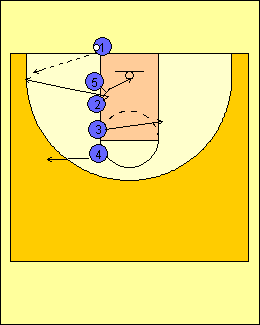
Same "line" alignment to begin each play. We have four play calls from this alignment: "1", "2", "3" and "13" Before beginning first play, you must know that the number calls are associated with the players in line. Player #5 is (1), Player #2 is (2), Player #3 is (3). Of course, because that is their position in line. If we call "1". In this diagram, the first player, #5, knows that it is his number and that he must screen the player "behind him". #5 turns and screens for #2 who pops to the corner for the open jumper. #3 breaks opposite and the top player breaks toward ball side wing area. |
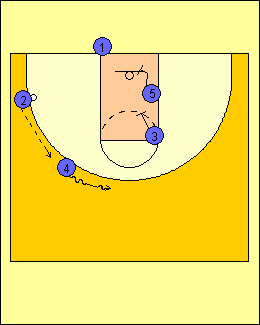
If the initial scoring opportunity is not available, i.e. if #2 does not have a shot, we will run the same conclusion to this play each time. #2 will reverse the ball to #4 who will "center" the ball while #5 and #3 set up a double staggered screen. |
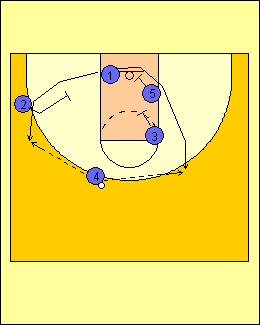
#1 now steps in and has the option of coming off the double staggered screen from #5 and #3 or the single screen on the left side from #2. |
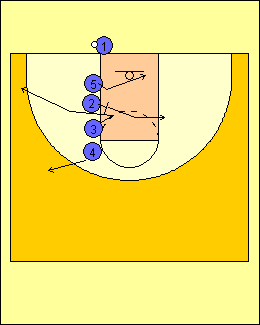
If we call "2". The second player in line knows that his number has been called and he must screen the man behind him. Here we see #5 breaking across the lane, which he will always do on each of these plays. Of course he will stop and screen first if his number ("1) is called. Since his number has been called, #2 screens for #3 who trys to get open on the ball side wing for the open jump shot. #2 contines across the lane after screening for #3. #4 will always break to the ball side wing (except for play "3" and "13"). Note: Just this season, on the #2 play, we are adding having #5 come back and "screen the screener", #2's defender. #2 would then cut across the lane and #5 would step to the ball after screening. |
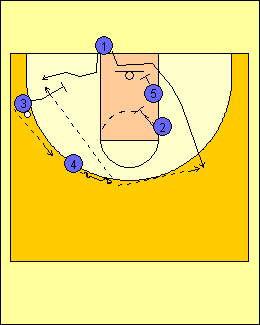
Same conclusion to the play here. #3, if he does not have a shot, reverses the ball to #4 on the wing who "centers" the ball. #1 steps in and either uses the single screen from #3 on the left side or the floor or uses the double staggered screen from #5 and #2 on the right side of the floor. |
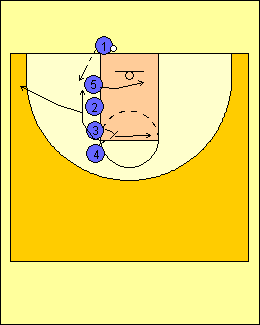
Play "3". The third person in line recognizes his number called and will turn and screen the man behind him. This time, since #4 is a post player he will cut straight down the middle looking for the inbounds pass from #1 and the lay-up. You will be surprised how often this is open (especially if #3 does his job and sets a good screen on #4's defender). As always, #5 cuts across the lane, #2 will always break opposite #5 if his number was not called. #3 cuts across the lane after screening which remains consistent with the rules of the other plays. |
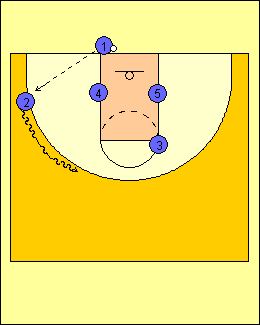
The play would then continue as normal. If #4 did not have a shot, #1 would inbounds to #2 on the left wing who would then "center" the ball himself since #4 was not available. |
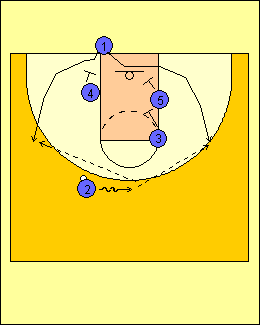
#2 then looks for #1 coming off the single screen from #4 on the left side of the floor or the double staggered screen from #5 and #3 on the right side of the floor. |
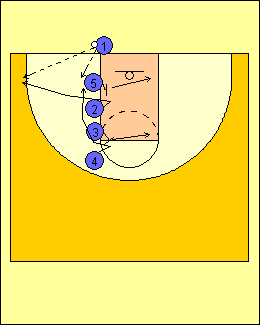
The last play call is "13" and might be the most effective. "Thirteen" is simply calling player "1" and player "3". Player #5 hears his number so he turns and screens the man behind him (#2). Player #3 hears his number so he turns and screens the player behind him (#4). This play gives you a double quick-hitter scoring opportunity. Again, the number called is to alert the person in line that he must screen the player behind him. The number called corresponds with the player's position in line, not his position with the team. Several plays....one alignment....difficult for your opponent to figure out. |
|
Created with Basketball Playbook from Jes-Soft
|